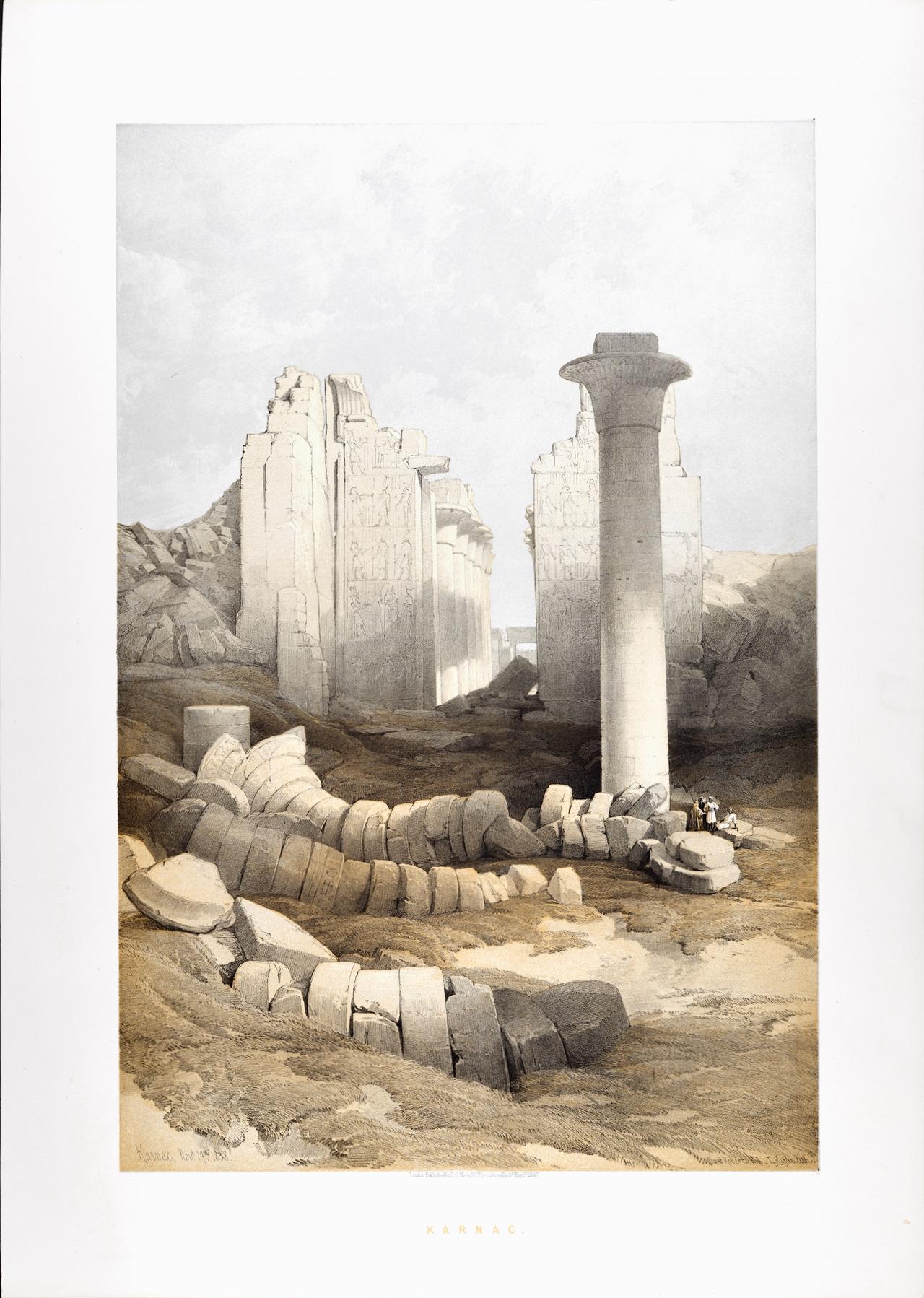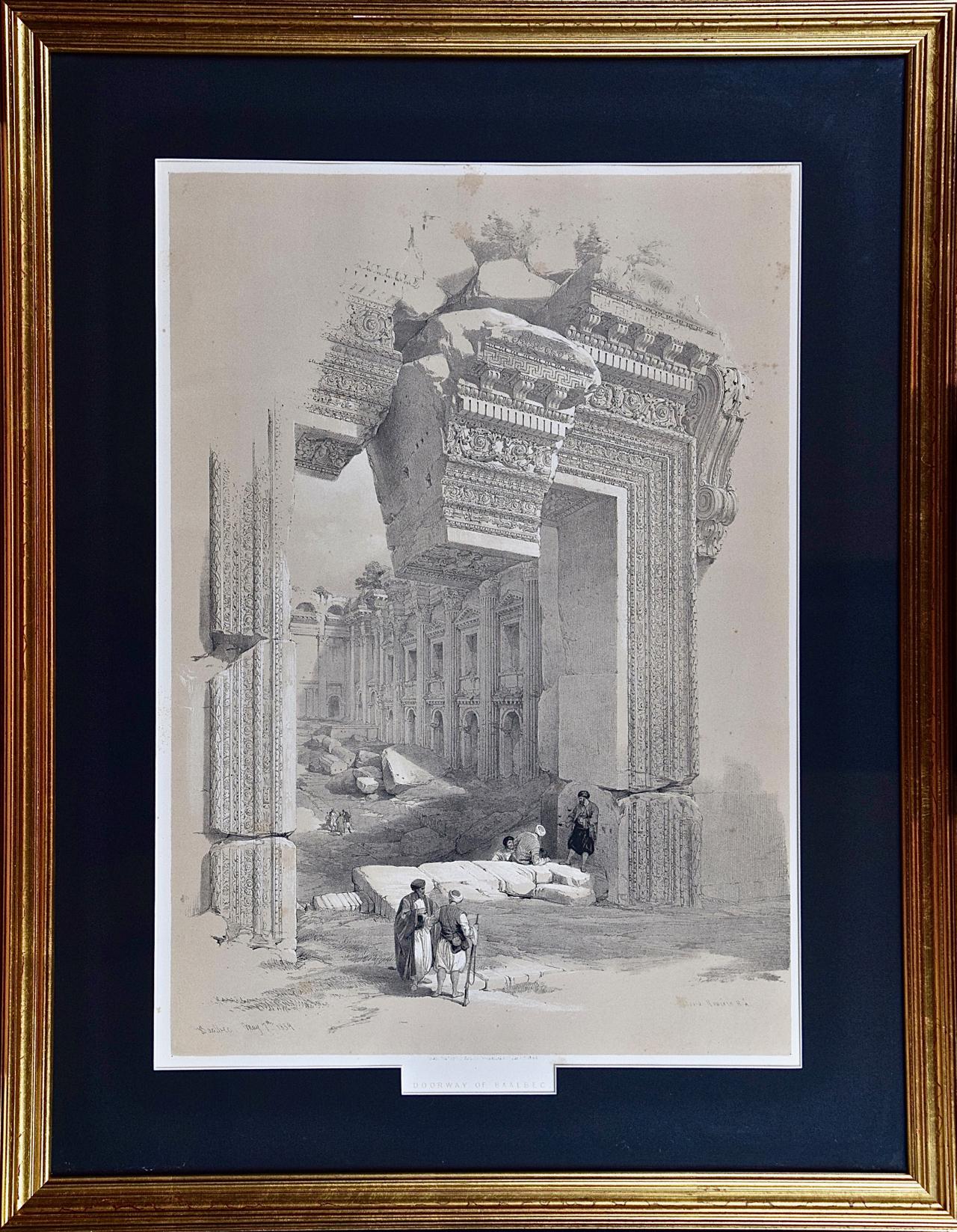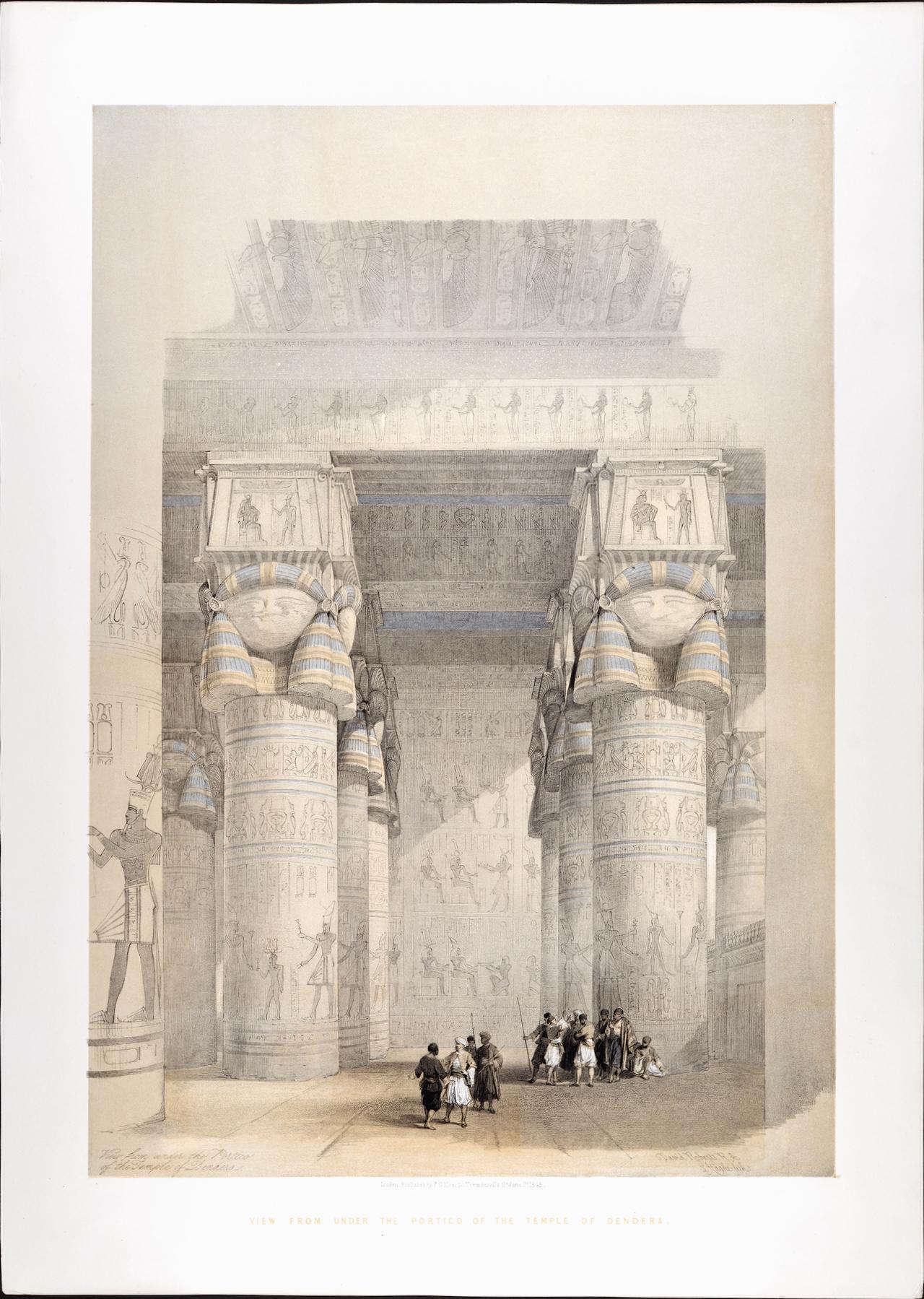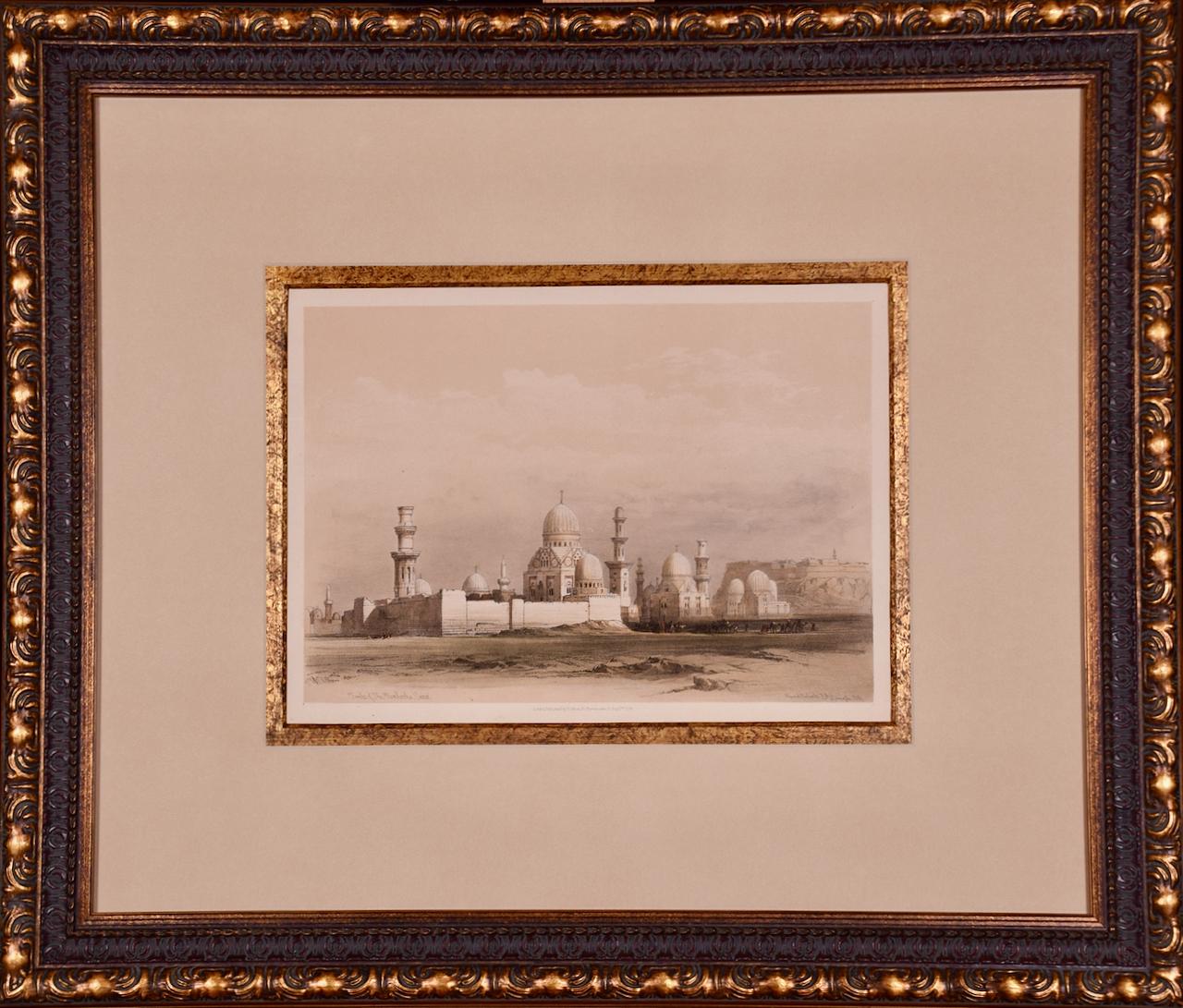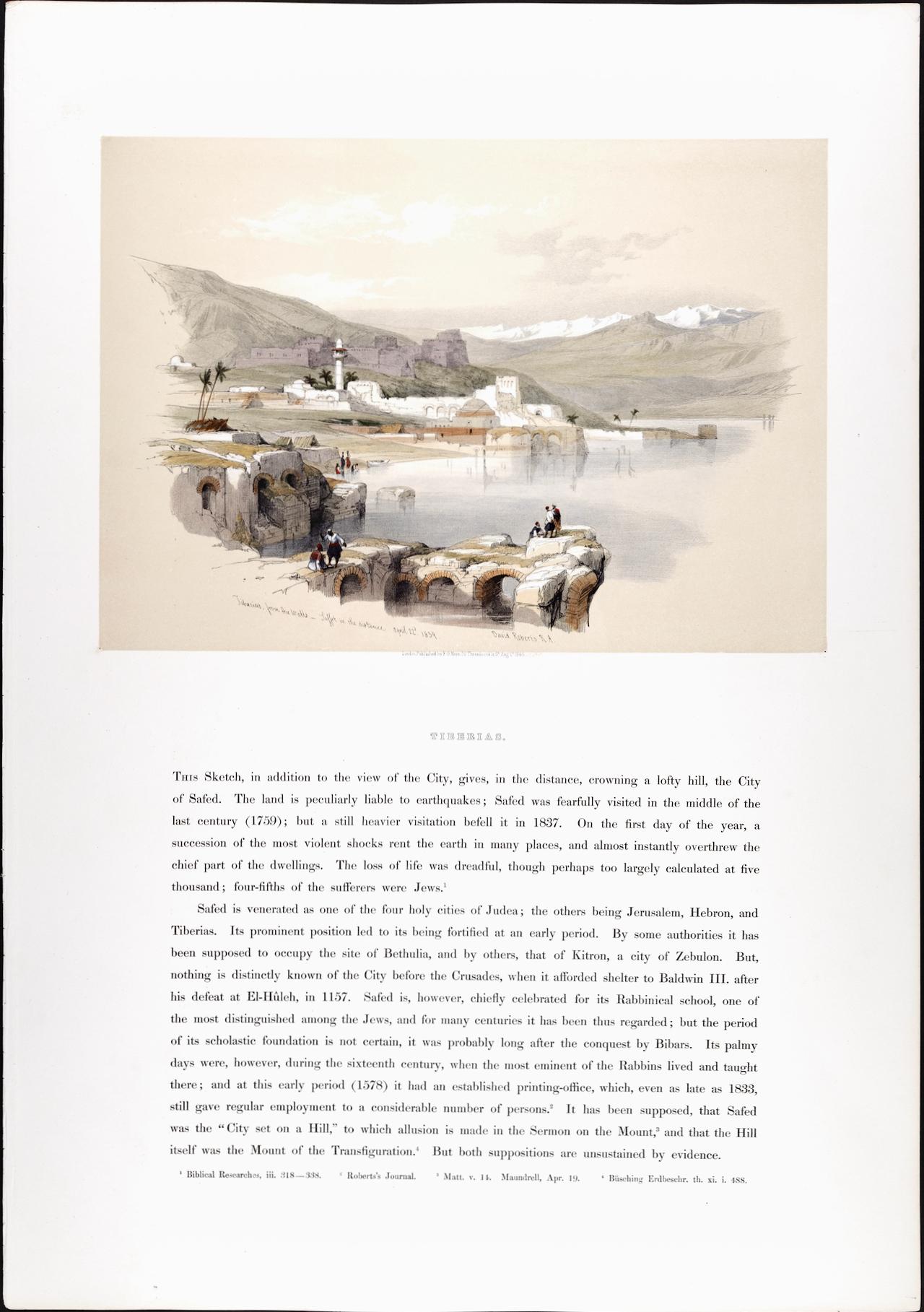David RobertsPillar of Absalom near Jerusalem: David Roberts' 19th C. Hand-colored Lithograph1841
1841
About the Item
- Creator:David Roberts (1796-1864, British)
- Creation Year:1841
- Dimensions:Height: 23.88 in (60.66 cm)Width: 17 in (43.18 cm)
- Medium:
- Movement & Style:
- Period:
- Framing:Framing Options Available
- Condition:
- Gallery Location:Alamo, CA
- Reference Number:
David Roberts
David Roberts was born outside of Edinburgh, Scotland. At age 10 he became a house painter’s apprentice. He continued painting houses and, eventually, theater scenes in Edinburgh and then in London. Roberts’ friend, J.M.W. Turner, recognized his artistic talent and encouraged him to become a full-time artist.
In 1839 Roberts traveled to Egypt and then in 1840, through the Holy Land, concluding in Jerusalem. Upon his return to England, F.G. Moon agreed to publish lithographs created by Louis Haghe from Roberts’ sketches and watercolors. This publication was highly acclaimed and very popular for its esthetic quality, its historical and topographical accuracy, and Roberts’ dramatic depiction of his scenes. Queen Victoria and Charles Dickens were among the subscribers who collected his works. Roberts’ and Haghe’s duotone lithographs, often colored, remain extremely sought after today and have been rising steadily in value.
Find original David Roberts paintings and prints on 1stDibs.
- ShippingRetrieving quote...Ships From: Alamo, CA
- Return PolicyA return for this item may be initiated within 7 days of delivery.
- Karnac, Egypt, Nov. 29, 1838: David Roberts' 19th C. Duotone LithographBy David RobertsLocated in Alamo, CAThis is an original 19th century hand-colored lithograph entitled "Karnac, Nov. 29, 1838" by David Roberts, from his Egypt and Nubia volumes of the large folio edition, published in ...Category
1840s Realist Interior Prints
MaterialsLithograph
- "The Doorway of Baalbec": A David Roberts' 19th Century Hand Colored LithographBy David RobertsLocated in Alamo, CA"The Doorway of Baalbec" is a 19th century full folio sized duotone lithograph, representing plate 81 in the Egypt and Nubia volumes of David Roberts’ large folio edition, published ...Category
1840s Realist Interior Prints
MaterialsLithograph
- Temple of Hathor, Dendera Egypt: David Roberts' 19th C. Hand-colored LithographBy David RobertsLocated in Alamo, CAThis is an original 19th century hand-colored lithograph entitled "View from Under the Portico of the Temple of Dendera" by David Roberts, from his Egypt and Nubia volumes of the lar...Category
1840s Realist Interior Prints
MaterialsLithograph
- "Entrance to the Citadel Cairo": David Roberts' 19th C. Hand Colored LithographBy David RobertsLocated in Alamo, CA"Entrance to the Citadel of Cairo" is a 19th century full folio sized duotone lithograph from the Egypt and Nubia volumes of David Roberts’ large folio edi...Category
1840s Realist Interior Prints
MaterialsLithograph
- View of Cairo, Egypt: A 19th C. Framed Hand-colored Lithograph by David RobertsBy David RobertsLocated in Alamo, CAThis is an original 19th century hand-colored lithograph entitled "Tombs of the Memlooks, Cairo" by David Roberts, from his Egypt and Nubia volumes of the large folio edition, publis...Category
1840s Realist Interior Prints
MaterialsLithograph
- Tiberias from the Walls: David Roberts' 19th C. Hand-colored LithographBy David RobertsLocated in Alamo, CAThis is an original 19th century hand-colored lithograph entitled "Tiberias from the Walls, Saffet (Safed) in the Distance" by David Roberts, from his Egypt and Nubia volumes of the large folio edition, published in London by F. G. Moon in 1841. The lithographs were prepared by Louis Haghe (1806-1885) from drawings and paintings by Roberts. The resultant large folio editions of 'The Holy Land' and 'Egypt & Nubia' are considered among the greatest lithographically illustrated works issued in the 19th century. This page from Roberts' 19th century publication includes a half-folio hand-colored lithograph of a view of the town of Tiberias and with the town of Safed on the hill in the distance. They lie along the Sea of Galilee...Category
1840s Realist Interior Prints
MaterialsLithograph
- The Window - Mandela, Former South African President, Signed Art, Robben IslandBy Nelson MandelaLocated in Knowle Lane, CranleighNelson Mandela, The Window, Signed Limited Edition Lithograph Many people are unaware that Nelson Mandela turned his hand to art in his 80's as a way of leaving a legacy for his family. He spent time with an art tutor and learnt to draw. In 2002, when creating the The Window print, he told Anna and Laura from Belgravia Gallery of his desire to become a full time artist when he retired. This sketch depicts a view of Table Mountain through the bars of a prison cell...Category
Early 2000s Contemporary Interior Prints
MaterialsLithograph
- The Ward - Mandela, Former South African President, Signed Art, Robben IslandBy Nelson MandelaLocated in Knowle Lane, CranleighNelson Mandela, The Ward, Signed Limited Edition Lithograph Many people are unaware that Nelson Mandela turned his hand to art in his 80's as a way of leaving a legacy for his family...Category
Early 2000s Contemporary Interior Prints
MaterialsLithograph
- Original Perlach Maccaroni - Spaghetti vintage poster pastaBy Richard RothLocated in Spokane, WAAn original vintage poster of Perlach Macaroni Spaghetti created by Richard Roth for the German pasta brand, Perlach in the 1940s 1. The poster features an anthropomorphic pasta man...Category
1940s Art Deco Interior Prints
MaterialsLithograph
- Original "Stufe Pagliero Michele" vintage Italian posterLocated in Spokane, WAOriginal Stufe Pagliero Michele vintage Italian antique poster. Archival linen backed and ready to frame. Lithograph from 1929. Excellent condition, ready to frame. A condition. Bright and vibrant colors. The company was founded in 1814 and is the oldest in Italy. Note there is a tax stamp on the left side near the word “Iipi,” as shown in 1 photograph. Italian terracotta and tile stoves are traditional heating devices that have been used in Italy for centuries. They are typically made from terracotta clay, a type of earthenware known for its heat-retaining properties. The stoves are often decorated with colorful tiles, creating a beautiful and functional piece of furniture. Terracotta stoves...Category
1920s Art Deco Interior Prints
MaterialsLithograph
- Hans Schleger 'Zero' London Transport Bus Stop c. 1970 Original PosterBy Hans Schleger ZeroLocated in London, GBTo see our other original vintage travel posters including more pre-war London Transport posters, scroll down to "More from this Seller" and below it click on "See all from this Seller" - or send us a message if you cannot find the poster you want. Hans Schleger 'Zero' (1898-1976) London Transport Coach Stop Poster Screenprint poster c. 1970 16x17.8 cm Printed for London Transport These posters were designed to be used as temporary stops when the usual stop required amendment for instance owing to road works or similar events. Printed on paper they were designed to be posted up at the alternative site, possibly over a different sort of stop (bus stop, coach stop, request stop, etc.). Working with Edward Johnson's special typeface created for London Transport, Hans Schleger - or Zero as he signed himself - adopted the famous roundel used by London Underground for use at Bus Stops. Born in Germany, Schleger was an influential graphic designer. After serving during the First World War, he studied at the Berlin Kunstgewerbeschule, being taught by Emil Orlik. The same year Walter Gropius founded the Bauhaus at Weimar and Schleger learned the same principles of breaking down the barriers between architecture, design, fine art and craft. A firm believer in the Bauhaus principles of simplicity in design and reduction to essentials, these may be seen in the clean lines of the roundel. In 1924 he moved to New York, applying Modernism to American advertising, and then returned to Berlin in 1929 working for the British advertising agency Crawfords, where he met Edward McKnight Kauffer who introduced him to Jack Beddington the head of advertising at Shell Mex...Category
1970s Modern Interior Prints
MaterialsLithograph
- Hans Schleger 'Zero' London Transport Coach Stop c. 1970 Original PosterBy Hans Schleger ZeroLocated in London, GBTo see our other original vintage travel posters including more pre-war London Transport posters, scroll down to "More from this Seller" and below it click on "See all from this Seller" - or send us a message if you cannot find the poster you want. Hans Schleger 'Zero' (1898-1976) London Transport Coach Stop Poster Screenprint poster c. 1970 16x20 cm Printed for London Transport These posters were designed to be used as temporary stops when the usual stop required amendment for instance owing to road works or similar events. Printed on paper they were designed to be posted up at the alternative site, possibly over a different sort of stop (bus stop, coach stop, request stop, etc.). Working with Edward Johnson's special typeface created for London Transport, Hans Schleger - or Zero as he signed himself - adopted the famous roundel used by London Underground for use at Bus Stops. Born in Germany, Schleger was an influential graphic designer. After serving during the First World War, he studied at the Berlin Kunstgewerbeschule, being taught by Emil Orlik. The same year Walter Gropius founded the Bauhaus at Weimar and Schleger learned the same principles of breaking down the barriers between architecture, design, fine art and craft. A firm believer in the Bauhaus principles of simplicity in design and reduction to essentials, these may be seen in the clean lines of the roundel. In 1924 he moved to New York, applying Modernism to American advertising, and then returned to Berlin in 1929 working for the British advertising...Category
1970s Interior Prints
MaterialsLithograph
